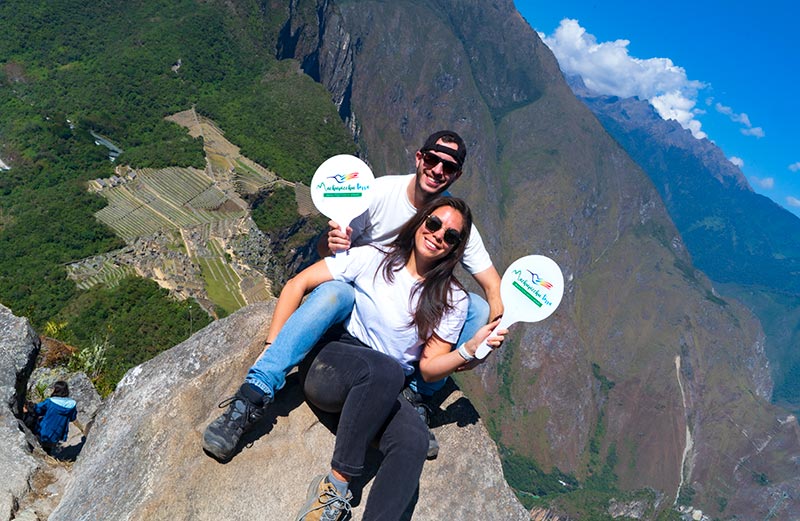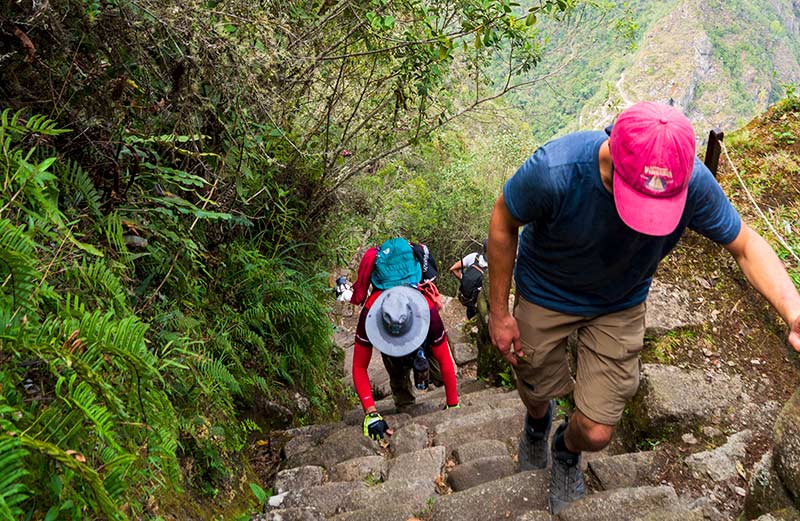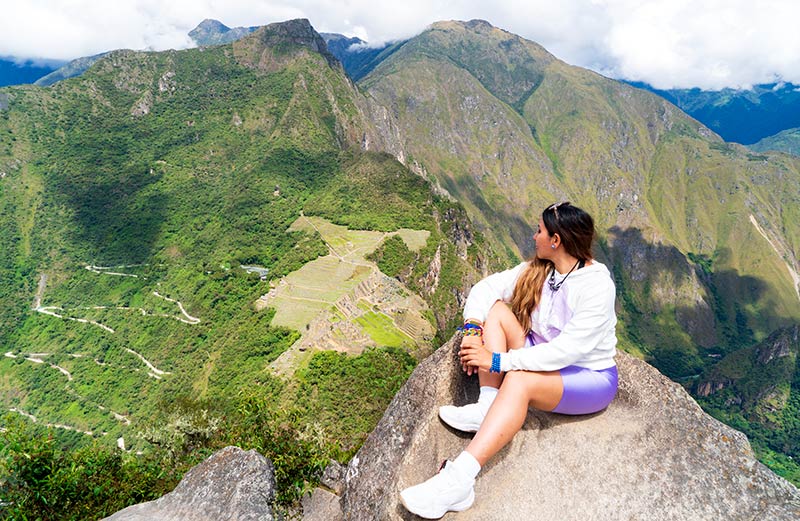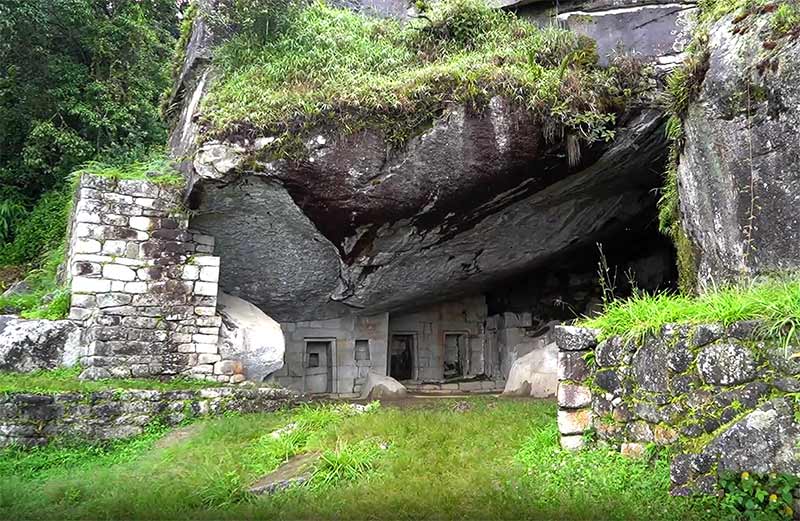Huayna Picchu Mountain
The Huayna Picchu is one of the mountains that surrounds the Inca citadel of Machu Picchu. From its summit, you have a panoramic view of the entire archaeological site. To reach the top you must hike 2 kilometers uphill (suitable for those over 12 years old). To make the visit you must choose3, the 1-day tour ‘Machupicchu + Huaynapicchu’. Learn more about Huayna Picchu mountain!
Content
The Huayna Picchu mountain
- La montaña Huayna Picchu o Wayna Picchu es una de las cumbres que rodean la ciudadela inca. Las otras montañas son el Huchuy Picchu y la montaña Machupicchu.
- El ‘Huayna’ es reconocido en las clásicas fotografías de la ciudadela inca. Su fama se debe a la desafiante ruta de senderismo que conduce hasta su cima. Ésta recorre aproximadamente 2 kilómetros cuesta arriba.
- The mountain was worshipped by the Incas. They were the ones who built a network of stone stairways to reach the top. There the Incas performed ceremonies of payment to the earth.
- Today the Huayna Picchu offers one of the most famous trekking routes in the visit to Machupicchu. The hike lasts between 1 to 2 hours depending on the physical condition of the visitor.
- To enter this mountain you must choose the tour ‘Machupicchu + Huaynapicchu’. The entrance to the mountain is suitable for visitors over 12 years old.
The hike to the summit of Huayna Picchu
The hike to Huayna Picchu mountain is one of the most challenging but memorable adventures on the visit to Machu Picchu.
The starting point of the hike is in the northern sector of Machu Picchu (a few steps from the Sacred Rock). There, to enter the mountain, you must show the ticket ‘Machupicchu + Huaynapicchu’.
The hike begins with a stretch through trails full of vegetation. At the beginning, the visitor must register his name in a control notebook. In this sector, there is a detour to the top of the Huchuy Picchu mountain. The other path leads to the top of Huayna Picchu.
Then continues a chain of stone steps made by the Incas. Between each step, there is an inclination of between 30 to 60 degrees. The hike to the top of Huayna Picchu takes between 1 to 2 hours, depending on the physical condition of each tourist.
On the hike, you can appreciate beautiful landscapes, terraces, and even religious temples, such as the Temple of the Moon (the Great Cavern). This last construction is located taking a detour (currently closed to visitors).
One of the most difficult sections on the way to Huayna Picchu is the so-called ‘stairways of death’. This route owes its name to the difficulty of crossing the stairs. The visitor must hold on to a metal rope (on one side of the stairs). No tourist has ever lost his life on these stairs.
Up the stairs, there are signs and signposts so no visitor gets lost. The hike is considered one of the most popular and adventurous in Machu Picchu.
What are the trekking tours to Machu Picchu?
Machu Picchu is a tourist destination that can be visited by trekking routes for several days. The Inca Trail of 4 days, the Salkantay trek of 5 days, the Lares trek of 4 days, the Huchuy Qosqo trek of 3 days, and the Inca Jungle of 4 days. The price of these trekking routes varies from US$300 to US$700 depending on the tourist agency you choose and the quality of the services they offer. All these tours include a visit to the Inca citadel of Machu Picchu.
The summit of Huayna Picchu
The summit of Huayna Picchu mountain is 2,693 meters above sea level. This is about 300 meters above the archaeological site of Machu Picchu, which is located at 2,430 meters above sea level.
At the top of Huayna Picchu, the visitor will be able to appreciate a panoramic view of the archaeological site that includes: the Inca citadel, its buildings, its terraces, the town of Aguas Calientes, the river, and the beautiful Vilcanota valley.
The top of Huayna Picchu offers a viewpoint. Normally there is a 5 minute queue to get a picture. However, along the hike, and at different points of the summit, you can get beautiful pictures.
The summit of Huayna Picchu is the second highest point in Machu Picchu (2,693 masl). The highest point is the summit of Machu Picchu mountain (3,082 masl).
The Temple of the Moon, the Great Cavern
The Temple of the Moon, also called the Great Cavern, is one of the most mysterious and striking religious constructions of Machu Picchu.
This Inca construction is located at the bottom and behind the Huayna Picchu mountain. The route to it is difficult to access by narrow roads.
To get to the Temple of the Moon you must take a detour from the top of the mountain. From there, it takes approximately 1 hour to get to the temple. Then, to continue to the exit of the mountain, you must walk for approximately 2 hours more.
The Temple of the Moon is built inside a cavern. It has thin stone walls, trapezoidal doorways, and niches where sacred objects were placed. Due to the few visitors that arrive there, this Inca construction is visited almost alone.
Currently, due to the danger of visiting the Temple of the Moon, it is closed to visitors.
Difference: Huayna Picchu and Machu Picchu mountain
These are the similarities and differences of the two most famous mountains in Machu Picchu: Huayna Picchu mountain and Machu Picchu mountain:
| Differences and similarities | Machu Picchu Mountain | Huayna Picchu Mountain |
|---|---|---|
| Location | In the northern sector of Machu Picchu | In the southern sector of Machu Picchu (near the Guardian’s House) |
| Height | 2,693 masl | 3,082 masl |
| Name | Young mountain | Old Mountain |
| Entrance door | A few steps from the Sacred Rock (inside Machu Picchu) | A few steps from the sector of the Guardian’s House (inside Machu Picchu). |
| Kilometers | 1.8 kilometers approx. | 2.2 kilometers approx. |
| Stairs | Nearly two thousand stone stairs | Nearly 1,500 stone staircases |
| Inca constructions | Agricultural terraces and religious temples | Agricultural terraces |
| Roads | Route with stairs with slopes ranging from 30 to 60 degrees. | Route with trails and stone stairs of 20 degrees. |
| Entrance | Entrance ticket ‘Machupicchu + Huaynapicchu’ | Entrance ticket ‘Machupicchu + Mountain’ |
| Restrictions | Suitable for visitors over 12 years old | Suitable for visitors of all ages |
Questions and Answers about Huayna Picchu
These are the most frequently asked questions by visitors about the visit to Huayna Picchu mountain in Machu Picchu:
Where is the Huayna Picchu mountain and is it inside Machu Picchu?
The Huayna Picchu mountain is located inside the archaeological site of Machu Picchu, in the Sacred Rock sector. To enter the mountain, you must enter the control gate showing your ticket.
Is Huayna Picchu open every day?
Yes, the Huayna Picchu mountain is open every day, including Sundays and holidays.
Can Huayna Picchu mountain be visited by everyone?
No, Huayna Picchu Mountain is suitable only for visitors over 12 years old.
How much does a tour to Huayna Picchu mountain cost?
The 1-day Huayna Picchu mountain tour costs $330 for foreign adults. In addition, the tour offers discounts for university students ($310), children under 18 ($300), and citizens of the Andean Community of Nations ($305).
What are the death stairs of Huayna Picchu?
The stairs of death are one of the most challenging sections on the way to the top of Huayna Picchu. This section has stairs with high slopes, so it is recommended to lean on the safety ropes. No visitor has ever lost their life here.
What is the Temple of the Moon and is it open to the public?
The Temple of the Moon is an Inca construction located at the back of Huayna Picchu. It is located inside a cave, so it is also called ‘The Great Cavern’. Due to the difficulty of reaching this building, it is currently not possible to enter.
Which mountain is higher, Huayna Picchu or Machu Picchu?
Huayna Picchu is located at 2,693 meters above sea level while Machu Picchu is the highest mountain at 3,082 meters above sea level.
How are the views from the top of Huayna Picchu mountain?
From the top of Huayna Picchu mountain, you have a panoramic view of Machu Picchu and the surrounding geographical environment: the Vilcanota River, the mountain range, the town of Aguas Calientes, and more.



